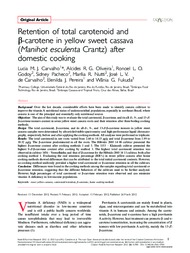Retention of total carotenoid and B-carotene in yellow sweet cassava (Manihot esculenta Crantz) after domestic cooking.
Retention of total carotenoid and B-carotene in yellow sweet cassava (Manihot esculenta Crantz) after domestic cooking.
Author(s): CARVALHO, L. M. J.; OLIVEIRA, A. R. G.; GODOY, R. L. O.; PACHECO, S.; NUTTI, M. R.; CARVALHO, J. L. V. de; PEREIRA, E. J.; FUKUDA, W. G.
Summary: Background: Over the last decade, considerable efforts have been made to identify cassava cultivars to improve the vitamin A nutritional status of undernourished populations, especially in northeast Brazil, where cassava is one of the principal and essentially only nutritional source. Objectives: The aim of this study was to evaluate the total carotenoid, ?-carotene, and its all-E-, 9-, and 13-Z-?- carotene isomers content in seven yellow sweet cassava roots and their retention after three boiling cooking methods. Design: The total carotenoid, ?-carotene, and its all-E-, 9-, and 13-Z-?-carotene isomers in yellow sweet cassava samples were determined by ultraviolet/visible spectrometry and high-performance liquid chromatography, respectively, before and after applying the cooking methods. All analyses were performed in triplicate. Results: The total carotenoid in raw roots varied from 2.64 to 14.15 µg/g and total b-carotene from 1.99 to 10.32 µg/g. The b-carotene predominated in all the roots. The H?brido 2003 14 08 cultivar presented the highest b-carotene content after cooking methods 1 and 3. The 1153 Klainasik cultivar presented the highest 9-Z-?-carotene content after cooking by method 3. The highest total carotenoid retention was observed in cultivar 1456 Vermelhinha and that of b-carotene for the H?brido 2003 14 11 cultivar, both after cooking method 1. Evaluating the real retention percentage (RR%) in sweet yellow cassava after home cooking methods showed differences that can be attributed to the total initial carotenoid contents. However, no cooking method uniformly provided a higher total carotenoid or ?-carotene retention in all the cultivars. Conclusion: Differences were found in the cooking methods among the samples regarding total carotenoid or ?-carotene retention, suggesting that the different behaviors of the cultivars need to be further analyzed. However, high percentages of total carotenoid or ?-carotene retention were observed and can minimize vitamin A deficiency in low-income populations.
Publication year: 2012
Types of publication: Journal article
Unit: Embrapa Food Technology
Observation
Some of Embrapa's publications are published as ePub files. To read them, use or download one of the following free software options to your computer or mobile device. Android: Google Play Books; IOS: iBooks; Windows and Linux: Calibre.
Access other publications
Access the Agricultural Research Database (BDPA) to consult Embrapa's full library collection and records.
Visit Embrapa Bookstore to purchase books and other publications sold by Embrapa.

